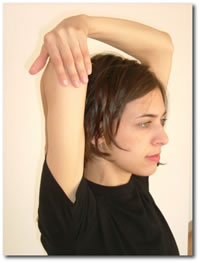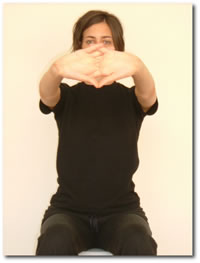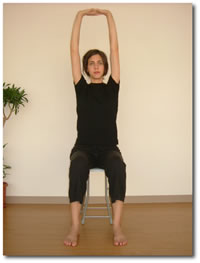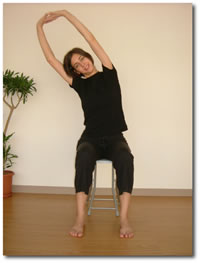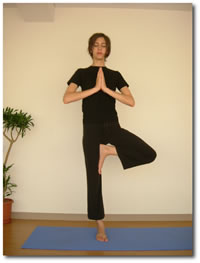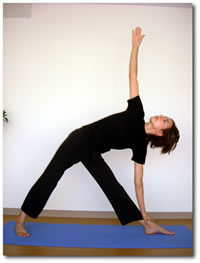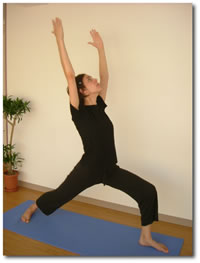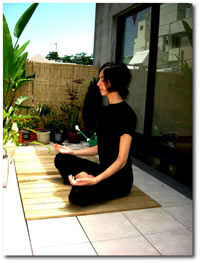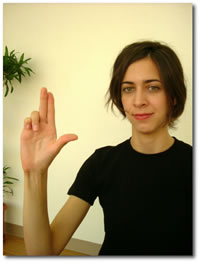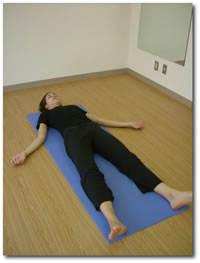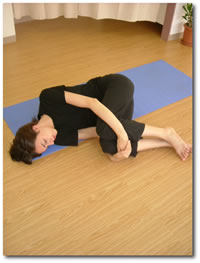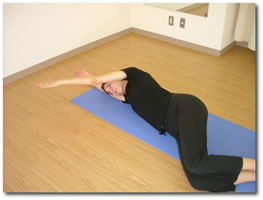 |
 |
 |
 |
 |
 |
 |
Take-out Yoga: Yoga for Modern Life with yogini Gwen Bell
Desk Yoga - Travel Yoga - Yoga for Anxiety - Decision Making Meditation - Alternate Nostril Breathing - Yoga for Sleep
Desk Yoga - Yoga at work in your chair
Q. I’m interested in yoga but I work long hours in an office and I’m too tired to go to a yoga studio after work. What can I do?
One of the reasons I enjoyed doing yoga so much when I began practicing is that it didn’t require me to have a ball, weights, surfboard or any other equipment to participate. All you need is your body. At work, first consider your desk set-up. Do you have to strain your eyes or neck to see your computer screen? If so, you may want to elevate your computer. Here are a few simple yoga stretches you can do throughout the day without leaving your desk.
Yogini Gwen BellFirst, place your feet about hips-width apart on the floor. Sit with your spine erect and directly over your hips by bringing your body forward and away from the chair back. Lengthen through your spine and as you do so, inhale and draw your shoulders up towards your ears. Exhale slowly, allowing the shoulders to return to a neutral position. Repeat throughout the day to release tension in the neck and shoulders.
On the next inhalation, lift both of your arms over your head. Bend the right arm and take hold of the right elbow with the left hand. Apply gentle pressure to the right elbow and breathe deeply for a count of 5. The neck is relaxed. Inhale, extend the arms up, and repeat on the opposite side. Bring the arms back down and interlace the fingers. On an exhalation stretch the arms out in front of the body, palms facing away from you, and hold for a count of 10. Extend the arms, hands still interlaced, overhead, and lean to the right for a count of 5. Repeat on the opposite side.
Breathing is what separates yoga from other types of exercise. Practice by inhaling through the nose, filling first the diaphragm, then the lungs, and finally the bottom of the throat with air. Exhale smoothly through the nose. Inhalations and exhalations are long and effortless, with the exhalations growing longer than the inhalations throughout your yoga practice. Try practicing breathing this way, taking complete breaths, throughout your day at work. One effect this breathing technique has is to increase the flow of oxygen in the body, thus creating a calming effect on it, reducing stress and increasing productivity. Pay attention to the gap between inhalations and exhalations, which will bring awareness to the present moment.
Travel Yoga
Q. I like yoga a lot. I find that I really miss it when I take a business trip because I’m more stressed and tired than usual. How can I take yoga with me when I travel?
Tree Pose - Travel YogaPracticing yoga in an airport, in-flight and at your hotel can bring a feeling of centeredness during travel. Try to find a quiet place in the airport if you have a layover or extra time. Many airports now have a non-denominational prayer room with some space to practice yoga, that’s where I do it. On the plane, a good place to practice is near the tail of the plane, close to the bathrooms. Of course it’s easier to do when there’s no turbulence and the fasten seat belt sign is off, but it’s up to you!
Triangle Pose - Travel YogaIn the airport or in-flight you can practice a short Flow with 2-3 minutes in each of the following standing poses: Tree, Triangle and Warrior 2. See the photos for how-to.
During the flight, try using the breathing exercise we talked about on Day 1, breathing deeply into the abdomen. Practice this counting meditation with the eyes closed: breathing in, think “1″, breathing out, “2″ and so on until you reach 10. If a thought enters the mind during your meditation, gently return to 1 and start over. Don’t be discouraged if you don’t get to 10 without a thought entering the mind— I never have either!
Warrior 2 - Travel YogaAt the hotel be sure to drink lots of water, go easy on the caffeine, get exercise and practice the standing flow once again, adding a few Sun Salutations if you have time and space to do so.
Yoga for Anxiety
Q. I have an interview this week and I’m nervous. Can yoga help me face my fears?
Yoga is an excellent tool for managing anxiety. Before an interview you may feel nervous about your own abilities, the company to which you’re applying, or change in general. Start your yoga practice by specifically identifying what you are nervous about. It may help to do a short visualization exercise to see yourself giving a stellar performance during the interview before you start your yoga practice.
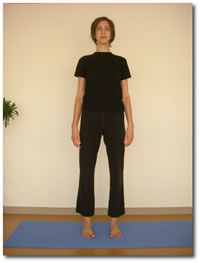
Mountain Pose - Yoga for AnxietyYoga for Balance
When you feel off balance it helps to do yoga poses that bring the body back into a balanced state. Start in Mountain pose, with the feet about shoulder width apart, the toes angled slightly towards one another. Lift all of the toes and then place them gently back down. Lift the kneecaps slightly and engage the thigh muscles. Find your center of balance here; the spine is elongated and the shoulder blades drawn together. Tuck the chin slightly and visualize a line from the ears, down to the shoulders, and continuing to the heels. If you have a floor-length mirror, check your alignment in this pose.
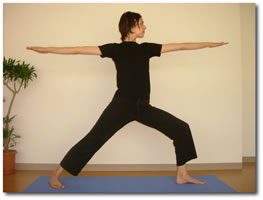
Warrior 1From here, step the right foot back as far as you comfortably can, coming onto the ball of that foot, moving into Warrior 1. The left knee is bent. Sink down toward the earth with both legs. Imagine yourself growing roots into the earth with your feet to help bring stability to the pose. Once you feel stable, reach both arms up overhead toward the ceiling. Reach with the fingertips; relax all tension in the shoulders, feel the curve in the lower back. Breathe deeply in this pose for 5-10 breaths and then repeat on the other side before doing Warrior 2 and returning to Mountain pose. These poses, coupled with deep breathing before, during and after the interview can help calm the body and mind, and prepare you for taking a giant, warrior-like step forward.
Decision Making Meditation
Q. I’m having trouble making a big decision. How can yoga help?
How we deal with a so-called big decision is usually a reflection of how we deal with so-called small decisions. Next time you’re making one of life’s many small decisions, to pay in cash or charge, for example, notice your physical and mental states. Does your breathing quicken? Do you feel anxiety when you have to make a minor decision? By noticing the daily decisions we make and making them in a decisive, openhearted manner, we are paving the way for making sound, clear-headed “big” decisions in the future.
Decision Making Meditation
When dealing with a big decision, find a place in your house or in a safe place and sit comfortably, either in a chair or in a cross-legged position with the hands resting on the knees, palms facing up. Begin by taking a few deep breaths, centering and calming the mind and noticing how the body and mind feel at the present moment. Allow the problem you are facing to arise naturally and sit with it. Notice whatever feelings come up and allow them to arise without judging or categorizing them. Explore all sides of the issue and if you begin to feel anxious, go back to “1″ and take ten or more deep breaths.There are no hard and fast answers to making a big decision, but by listening carefully during meditation and daily yoga practice, we can make the process of making a decision easier. Cultivating stillness in meditation allows decisions to arise naturally. Although a decision may arise during our workday or while we’re out shopping for groceries, we may not be able to listen at those times. During meditation we give ourselves the space and time we need to listen to our bodies’ intuition and to allow decisions to arise naturally.
Alternate Nostril Breathing
Q. I’m moving to a new city to start a new job. I have a lot of anxiety about the move. Are there any yogic breathing exercises will help me prepare for this major change?
During a major change, such as moving to a new place or starting a family, our tendency is to want to hide out or get away from it all. When I moved to Japan I had to force myself to pack up boxes, close bank accounts and say good-bye to old friends. It sucked, but change is an inevitable part of growth. So let’s take a look at a breathing exercise that encourages balance.
Alternate Nostril BreathingAgain, find a quiet, comfortable place in which to practice. Sit in a comfortable cross-legged position and take a few complete breaths; depending on the amount of time you have, you can center yourself for 5-10 minutes. Breathe deeply into the belly and each time you exhale allow the out breath to lengthen. Our tendency when we get nervous is to use our reserve area, the top 20% or so of our lungs, and we breathe in a shallow and quick way. Completely filling the diaphragm saves the reserve area for times when we really need it, like running from a bear during a camping trip. (I hope you never have to!)
The best explanation I have heard for this style of breathing comes from Bri. Maya Tiwari’s excellent, The Path of Practice: A Woman’s Book of Ayurvedic Healing.
 Alternate Nostril Breathing |
“Block your left nostril with your right ring finger and pinkie, and inhale through your right nostril. Then block your right nostril with your right thumb and exhale through your left nostril. Continue alternating right and left nostrils for approximately ten minutes. Be sure to always inhale through the same nostril from which you just exhaled. As you become more adept, you can work your way up to inhaling for eight counts, exhaling for sixteen.”
Regular practice of alternate-nostril breathing calms the mind, centers the body, balances the emotions and grounds you, all of which will be of tremendous help during a major change in your life.
Q. When I try to fall asleep, my mind is filled with worries and nervous energy. Is there a connection between yoga and good sleep?
Most of us suffer from insomnia from time to time, and there is a proven link between a regular yoga routine and relief for chronic fatigue. Before lying down to go to sleep, try doing relaxing or restorative yoga and meditation.
Yoga for Sleep
Sleep Yoga Flow
Begin in Corpse pose, with the entire back resting on the floor, the chin slightly tucked and the eyes closed. The arms and legs are relaxed and the heart area is open. Bring the knees to the chest and squeeze them towards you with your arms wrapped around the legs. Inhale, then exhale and roll over onto your right side. Yawn. Stretch the legs out and remain on your side. Bring the left arm straight out in front of the body. With an inhalation, rotate the arm up towards the head, exhale and continue bringing the arm around, in essence making a gigantic circle with the arm. Inhale; the arm comes back to center. Breathe slowly and mindfully as you make these circles. Then use the left arm to roll back into Corpse pose. Repeat on the other side, allowing the arm to hang in the places that you feel tightness. Breathe into the tight areas, and allow the breath to relax and tension in the shoulders.
Yoga for SleepWhen you’ve finished the shoulder rotations (1-2 minutes on each side), roll again onto your back and take the arms out into a T-shape at shoulder level. Lift the knees toward the chest and on an exhale allow the knees to drop slowly towards the floor. The head rolls gently to the side opposite the knees (the knees drop to the left, the head to the right). Close the eyes. Breathe and allow the body to relax in this pose before coming back to center and repeating on the opposite side. Take 5 minutes rotating between right and left before relaxing again in Corpse for 5-7 minutes, visualizing the body softening and sinking deeply into the floor/bed.
Yoga for SleepQ. Everything’s going great! I’m healthy, I like my job and I do yoga every week. Where do I go from here?
Fantastic question! I often contemplate this question myself. The answer is as wide and as varied as there are people in the world. Ask 100 yoga teachers and they’ll each tell you something a little different.
I believe living your life in a way that is balanced and flowing is one way to continue growing as a person and as a yoga student. Educate yourself about the yogic way of life, question everything and seek to do no harm and to help others.
If you practice yoga in a studio every week, try to incorporate what you’re learning there into your daily life. Build a regular practice at home and try to spend a few minutes each day in quiet meditation. Even a few minutes each day spent contemplating the breath or listening to your inner wisdom can help create a lifetime of stillness and openness.
These are my recommendations. What do you think will help you create more space, peace and wholeness in your life? In the world? Start there.
Contact Gwen at her website http://gwenbell.com
Home
•
Naturopath •
Aromatherapist •
SHOPPING ONLINE • Contact
Us
Healers,
Teachers & Creative People • Magazine
- Online • Useful
Info
Meditation,
Mantras & Prayer • Vegetarian
Info • Famous
Vegetarians •
Links

